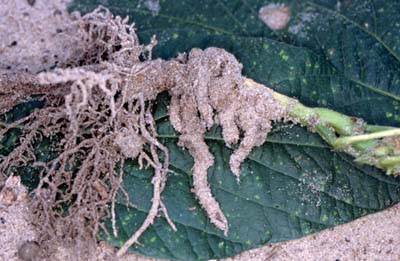
Lesser cornstalk borer, Elasmopalpus lignosellus,
showing soil tubes formed below ground by the larvae.
(Photographer: J. Castner, University of Florida)
The lesser corn stalk borer damages several crops but seems to prefer legumes and grass crops. Vegetable crops that are injured include bean, beet, cabbage, cantaloupe, corn, cowpea, lima bean, pea, pepper, sweet potato, tomato, and turnip. The larval stage causes damage when it feeds on and tunnels in the stem of plants. Tunneling is usually restricted to the below ground portion of the plant and girdling may also occur. Plant death is not uncommon and infested areas of the field are characterized by a thin stand. Populations of lesser corn stalk borer are highest during warm, dry weather. Fields may be sampled to determine larval populations by sieving or flotation of the soil. Light traps and pheromone traps may also be used to determine adult populations in the field. Cultural practices that are used to manage insect populations include early planting dates, tillage, and the destruction of weeds that serve as alternate hosts. Insecticides that are used are usually applied as a granular formulation in the seed furrow or as a band over the seedbed.
Images
To save the Web-optimized images shown below to your hard drive:
|
Click to access Display and Print quality images. |
|
Click to access Display and Print quality images. |
|
Click to access Display and Print quality images. |
|
Click to access Display and Print quality images. |